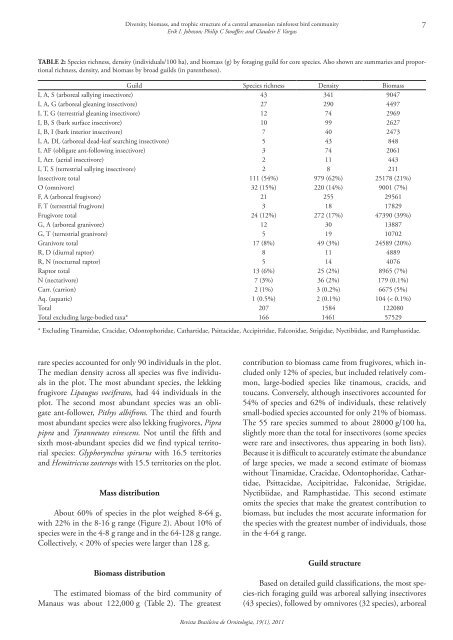Capa 19(1) - fechada.indd - Sociedade Brasileira de Ornitologia
Capa 19(1) - fechada.indd - Sociedade Brasileira de Ornitologia
Capa 19(1) - fechada.indd - Sociedade Brasileira de Ornitologia
Create successful ePaper yourself
Turn your PDF publications into a flip-book with our unique Google optimized e-Paper software.
Diversity, biomass, and trophic structure of a central amazonian rainforest bird community<br />
Erik I. Johnson; Philip C Stouffer; and Clau<strong>de</strong>ir F. Vargas<br />
7<br />
Table 2: Species richness, <strong>de</strong>nsity (individuals/100 ha), and biomass (g) by foraging guild for core species. Also shown are summaries and proportional<br />
richness, <strong>de</strong>nsity, and biomass by broad guilds (in parentheses).<br />
Guild Species richness Density Biomass<br />
I, A, S (arboreal sallying insectivore) 43 341 9047<br />
I, A, G (arboreal gleaning insectivore) 27 290 4497<br />
I, T, G (terrestrial gleaning insectivore) 12 74 2969<br />
I, B, S (bark surface insectivore) 10 99 2627<br />
I, B, I (bark interior insectivore) 7 40 2473<br />
I, A, DL (arboreal <strong>de</strong>ad-leaf searching insectivore) 5 43 848<br />
I, AF (obligate ant-following insectivore) 3 74 2061<br />
I, Aer. (aerial insectivore) 2 11 443<br />
I, T, S (terrestrial sallying insectivore) 2 8 211<br />
Insectivore total 111 (54%) 979 (62%) 25178 (21%)<br />
O (omnivore) 32 (15%) 220 (14%) 9001 (7%)<br />
F, A (arboreal frugivore) 21 255 29561<br />
F, T (terrestrial frugivore) 3 18 17829<br />
Frugivore total 24 (12%) 272 (17%) 47390 (39%)<br />
G, A (arboreal granivore) 12 30 13887<br />
G, T (terrestrial granivore) 5 <strong>19</strong> 10702<br />
Granivore total 17 (8%) 49 (3%) 24589 (20%)<br />
R, D (diurnal raptor) 8 11 4889<br />
R, N (nocturnal raptor) 5 14 4076<br />
Raptor total 13 (6%) 25 (2%) 8965 (7%)<br />
N (nectarivore) 7 (3%) 36 (2%) 179 (0.1%)<br />
Carr. (carrion) 2 (1%) 3 (0.2%) 6675 (5%)<br />
Aq. (aquatic) 1 (0.5%) 2 (0.1%) 104 (< 0.1%)<br />
Total 207 1584 122080<br />
Total excluding large-bodied taxa* 166 1461 57529<br />
* Excluding Tinamidae, Cracidae, Odontophoridae, Cathartidae, Psittacidae, Accipitridae, Falconidae, Strigidae, Nyctibiidae, and Ramphastidae.<br />
rare species accounted for only 90 individuals in the plot.<br />
The median <strong>de</strong>nsity across all species was five individuals<br />
in the plot. The most abundant species, the lekking<br />
frugivore Lipaugus vociferans, had 44 individuals in the<br />
plot. The second most abundant species was an obligate<br />
ant-follower, Pithys albifrons. The third and fourth<br />
most abundant species were also lekking frugivores, Pipra<br />
pipra and Tyranneutes virescens. Not until the fifth and<br />
sixth most-abundant species did we find typical territorial<br />
species: Glyphorynchus spirurus with 16.5 territories<br />
and Hemitriccus zosterops with 15.5 territories on the plot.<br />
Mass distribution<br />
About 60% of species in the plot weighed 8‐64 g,<br />
with 22% in the 8‐16 g range (Figure 2). About 10% of<br />
species were in the 4‐8 g range and in the 64‐128 g range.<br />
Collectively, < 20% of species were larger than 128 g.<br />
Biomass distribution<br />
The estimated biomass of the bird community of<br />
Manaus was about 122,000 g (Table 2). The greatest<br />
contribution to biomass came from frugivores, which inclu<strong>de</strong>d<br />
only 12% of species, but inclu<strong>de</strong>d relatively common,<br />
large-bodied species like tinamous, cracids, and<br />
toucans. Conversely, although insectivores accounted for<br />
54% of species and 62% of individuals, these relatively<br />
small-bodied species accounted for only 21% of biomass.<br />
The 55 rare species summed to about 28000 g/100 ha,<br />
slightly more than the total for insectivores (some species<br />
were rare and insectivores, thus appearing in both lists).<br />
Because it is difficult to accurately estimate the abundance<br />
of large species, we ma<strong>de</strong> a second estimate of biomass<br />
without Tinamidae, Cracidae, Odontophoridae, Cathartidae,<br />
Psittacidae, Accipitridae, Falconidae, Strigidae,<br />
Nyctibiidae, and Ramphastidae. This second estimate<br />
omits the species that make the greatest contribution to<br />
biomass, but inclu<strong>de</strong>s the most accurate information for<br />
the species with the greatest number of individuals, those<br />
in the 4‐64 g range.<br />
Guild structure<br />
Based on <strong>de</strong>tailed guild classifications, the most species-rich<br />
foraging guild was arboreal sallying insectivores<br />
(43 species), followed by omnivores (32 species), arboreal<br />
Revista <strong>Brasileira</strong> <strong>de</strong> <strong>Ornitologia</strong>, <strong>19</strong>(1), 2011

















